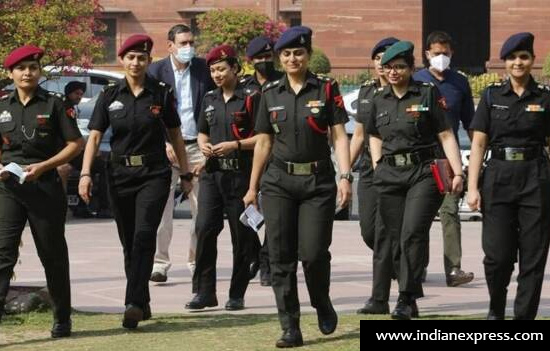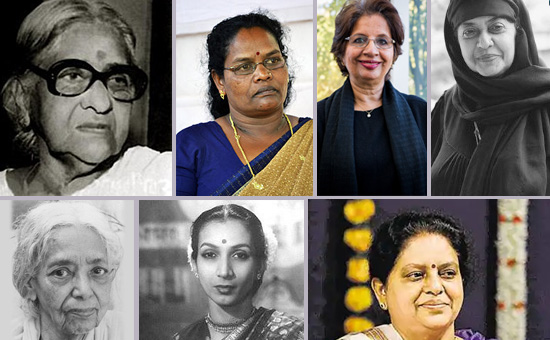- India had its first woman Supreme Court
Judge in 1987. Today, 3 out of 34 SC judges are women. It is clear that
women judges are under-represented in the higher judiciary. It is time the
higher judiciary takes cognisance of the problems and paves the way for a
change.
Did you know that from “1950 to November 2015 only six women became Supreme Court judges out of a total 229 judges appointed?”
The first female judge was appointed in
1987, 37 years after the supreme court of India was established, even though
India got its first women Prime Minister in 1966.
Seventy-three years since India became
a Republic she has today has a woman president, head of regulator SEBI but not a
woman chief justice and women are allowed to head combat units! This is although God is worshipped as Mother in
Indian tradition
Retired Judge Indu Malhotra said in a 2018 panel discussion hosted by Vidhi Centre for Legal Policy, “There is a gender bias in the legal profession and judiciary. People think women judges are not good enough to grapple with complicate commercial matters....sometimes, even a senior judge would turn around to say you would not understand it so you have to work twice as hard, you have to fight your way and struggle it out.” Source Livelaw
To
know the extent of women representation in the Higher Judiciary I visited the
Supreme Court (SC) and select High Court (HC) sites on March 31, 2023. Read on.
Table 1 - Number of Women Judges in SC
and 4 High Courts
|
Court
|
A-Judges as on 31.3.23
|
B-Women 31.3.23
|
Women 13.6.21
|
Women
12.4.16
|
C=B/A%
|
|
Supreme Court
|
34
|
3
|
1
|
1
|
9
|
|
Delhi HC
|
45
|
10
|
6
|
10
|
22
|
|
Bombay HC
|
42
|
5
|
5
|
10
|
-
|
|
Additional J
|
23
|
5
|
NA
|
NA
|
15
|
|
Madras HC
|
59
|
14
|
13
|
5
|
24
|
|
Calcutta HC
|
52
|
8
|
4
|
6
|
15
|
|
Total
|
255
|
45
|
29
|
32
|
18
|
|
ChandigarhHC
|
65
|
14
|
NA
|
7
|
22
|
|
Bangalore HC
|
54
|
5
|
NA
|
NA
|
9
|
% rounded off. Chandigarh HC is Punjab and Haryana High
Court. NA is not available. J stands for judges. Earlier year data taken from
my published articles on subject.
In absolute numbers the number of women
judges has gone up from 29 in 2021 to 45 in 2023. However, in the Supreme and
four high courts, the number of women judges as a % of total number of judges
is 18. However, there are huge variations between courts.
The lowest is 9% for the Supreme Court
and highest is 24% for Madras HC. It is the Delhi and Madras HCs that improve the
average number.
Punjab and Haryana high court has 22%
of women judges. The high percentage in Madras high court is not reflected in the
Bangalore high court.
There is something right being done by
the Collegium of the Madras high court because even in June 2021 it had the
highest number of women judges. Delhi high court had 10 judges in 2016 and
2023.
It is clear, based on
the above data, that the Higher Judiciary (HJ) is Male dominated. If women judges are
considered not good enough or incompetent by the all male Collegium the people
of India should be told so and a plan for affirmative action be spelt out.
It was very nice to read what Justice Hina Kohli of the SC said at a recent event on International Women’s Day, “It is a recognition of the fact that women, who constitute almost 50% of the total population in India and are going to dominate the workforce in the next few decades, are given their place under the Sun.” Source BarnBench
Is it time for SC to walk the talk as industrialist Anand Mahindra said at Davos.
 Women officers of the Indian Army at an event in Delhi.
Women officers of the Indian Army at an event in Delhi.
Women, after all, bring many positives
to the work place.
A Bengaluru based lady Chief Financial Officer of a services company says that women have many strengths for e.g. empathy so take team along with them, by nature women are more rigorous means the level of diligence, attention to detail is higher thus better executors. Finally, women hold themselves to a higher standard which percolates to team so overall team output is better.”
She ends with a caveat. “I am not into this women-man comparison and believe each individual, man or woman is different.”
According to survey results in a
2019 Mckinsey article titled When women
lead workplaces should listen, “women, more frequently than men, exhibit leadership traits that are highly applicable to future global challenges namely inspiration, participative decision making, expectation and rewards, people development and role modelling.”
I spoke to a Delhi based practicing senior council on why fewer women lawyers and judges in the HF? He said, “There are many women lawyers, actually more than any other profession. Judges not as many since women don’t last the distance. It takes a lot to rise to the top in this profession. Women are constrained by families and their own will to put their career first.”
A member of the Supreme Court Women Lawyer’s Association told this
author that what is required is a mindset change amongst all so that women are
placed on an equal footing. Here are her thoughts.
One, there is a perception that women
are not competent to deal with litigation esp. in criminal cases so first
choice is always male lawyers.
Two, since the profession is male
dominated and women made a late entry some sort of reservation for women, as
exists for others in the Constitution, should be introduced that would enable
them to catch up.
Three, need proper toilets for women esp.
in the district and taluka courts. If the number of woman lawyers increase they
can respond to harassment and sexually coloured remarks made say during say Bar
Association elections.
Four, all must understand that motherhood
and management of family responsibilities puts additional pressure on women. She
adds that when family matters go to the Apex Court women are in a better
position to mediate.
Will the HJ take cognizance and make it
easier for women?
Independent Director and Senior human resources
professional Aparna Sharma wrote in Business Manager, Let
us not make men out of women, “Again God has empowered women with the responsibility of child birth, so they should be supported during pregnancy and post delivery. This could take the form of crèches at work, flexible working hours and denial of loss of seniority for women who opt for career breaks.”
Another Mckinsey article states, “It’s increasingly important to women leaders that they work for companies that prioritize flexibility, employee well-being, and diversity, equity, and inclusion (DEI).” If companies fail to do so they might lose the next generation of leaders in this case judges in the HJ.
Aparna adds, “A level playing field without any special privileges/ concessions is the best way to start and stay on course. It amounts to hard work, personal sacrifices and strong commitment that holds true irrespective of the gender.”
A Cambridge educated lawyer now professor in a private law school says that “Women as lawyers/judges are more likely to be advancing policies on women empowerment. Not to say that men won't or don't.”
Another plus is that most women are rooted in Indian traditions so bring an understanding and sense of balance as done in the Sabarimala matter.
 Kerala’s outstanding women include a ex-foreign secretary.
Kerala’s outstanding women include a ex-foreign secretary.
So what can the Centre and HJ do?
Make it mandatory under law to have a Women
Judge in the Collegium and a minimum
percentage of women judges in the HJ say 25% increasing every year by a
percentage point for say the next eight years.
Note that the Executive
Committee of the Supreme Court Bar Association for 2022-23 has three women out of twelve members. If this reservation
means increasing the number of judges, so be it.
Read SC stays Nagaland government move
to cancel local body polls with 33% reservation for women
Since the collegium system of
appointment is not mentioned in the Constitution implementing the mandatory bit
could be tricky. Nevertheless, Parliament must introduce this law in the name
of women empowerment and build public opinion against male domination.
If there is a shortage of women judge
candidates the Collegium can overlook seniority and take some Delhi and Madras
high court judges.
The Centre must fund lady washrooms
in all district and taluka courts. They should thereafter, be maintained by the
court bar association.
The state level Bar Association would
be overall responsible for their maintenance with a system for complaint
resolution. The buck stops with the Chief Justice of the High Court.
Women lawyers must document their
success in cases through articles in media. This will create awareness about
their competence. TV channels can help by inviting them on prime time debates.
A bit of social change is required.
Families of Judges must support, in more ways than one, when their lady family
member is a judge.
HJ must make it safer for women lawyers and judges. If not done so already the HJ must introduce Vishaka guidelines in all courts. Read SC must follow the Vishaka spirit . A review of the SC site shows a
Gender Sensitization and Internal Complaints Committee exist. Details can be
viewed here
Note that “The Vishaka Guidelines were a set of procedural guidelines for use in India in cases of sexual harassment. They were promulgated by SC in 1997 and were superseded in 2013 by the Sexual Harassment of Women at Workplace (Prevention, Prohibition and Redressal) Act.”
Effecting change is never easy. Ask
those behind the Farm Laws.
Utmost care was taken in culling out data. Errors
if any are unintended and without mala fide intent.
Years ago, when I worked in the finance department
of Hindustan Lever, a lady accounts officer told me that she made sure work was
complete by 6.30 pm since she had to leave to fulfil home responsibilities.
With a smile then said, men can hang around longer!
More women judges, if empowered, will restore
balance and might be the key to improving the judgement delivery system/clearing
backlog of cases.
Disclosure - Since my mother became a doctor in the early 1950’s and practiced for decades thereafter, my views could be biased in favour working women.
First published in Swarajyamag
To read all articles on Indian
Women
Also read
1. Kerala’s outstanding women
2. Unsung Women Warriors of India
3. List of Women Judges in SC of India